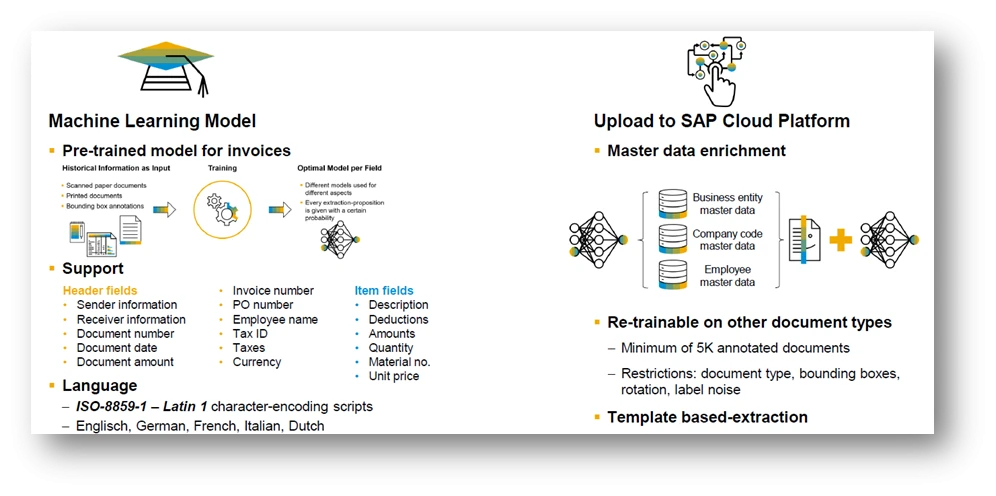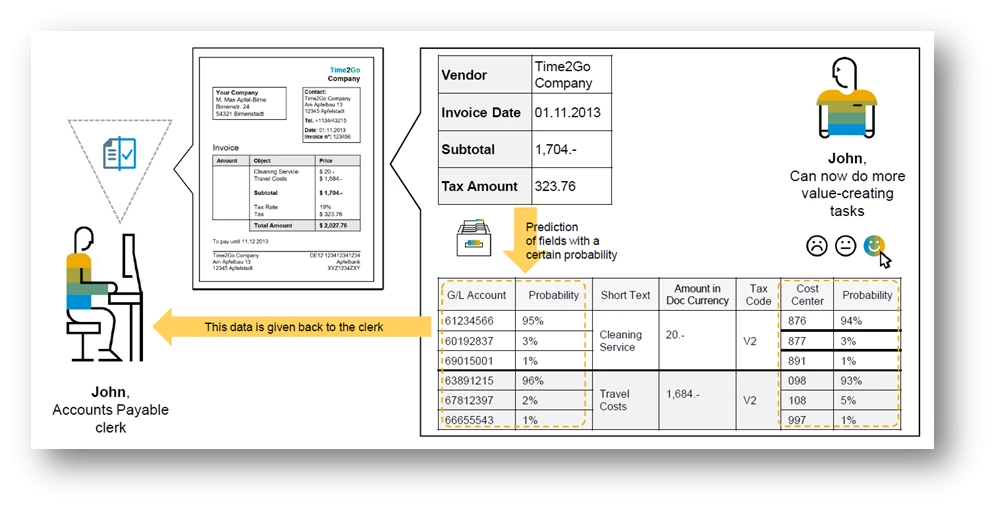SAP Artificial Intelligence - 7 AI Business Services offered by SAP
SAP Artificial Intelligence - 7 AI Business Services offered by SAP.
AI is no longer a futuristic scenario as depicted in sci-fi movies - it has started percolating down to mainstream business tasks. In spite of a high level of digitisation of documents and communication in businesses, more than 50% of workforce time in areas such as Finance and Procurement are devoted to collecting and processing data manually (according to a report by McKinsey). This offers enormous potential for automation using AI, which is exactly addressed by SAP’s offering of AI Business Services.
SAP Offers Business Services which can be integrated into business processes using SAP Cloud Platform. Enhanced with data and pre-built AI models, SAP is currently offering seven AI Business Services as shown in exhibit-1 below. They can be fruitfully deployed in specific areas where there is a repetitive manual task to be performed based on intelligence gained and applied in specific processes. These services are more generic in nature and they can be used in multiple scenarios. They are covered as part of the Cloud Platform Enterprise Agreement with customers.

Exhibit-1 (Credits : SAP SE)
Let us briefly examine the following three points from above in this blog:
- Business Document Processing Services
- Data Attribute Recommendation Services
- Invoice Object Recommendation Services
Business Document Processing Services:
Every organisation receives a number of documents such as vendor invoices for processing daily. Even an email with an attachment of a digital invoice needs to be processed manually by matching key information like vendor code, item code, price etc to the approved Purchase Order. There are many such documents like payment requests, customer orders and so on. Hence the first step is to extract the documents embedded in the mail, then classify them as to the correct type of document e.g. invoice, customer order, etc. Then finally recognise the objects inside these documents into structured data packets to make them suitable for proposing them at the right point in process for a worker. Hence SAP has provided these activities as three different services and bundled them as Business Document Processing Services. We will understand each of these three services mentioned below in a little more detail:
- Information Extraction Service
- Classification Service
- Business Entity Recognition Service
Information Extraction Service
Typically a clerk looks at the incoming mail with attached document and reads through the document, for example vendor invoice. Then they will type the values such as vendor number into the ERP system. This service extracts the same information and proposes them at the appropriate process for the clerk. The extracted information can be enriched with master data e.g. customer number, vendor number, etc. The service also provides a UI for the user to view the uploaded document and extracted results side by side. The clerk can process the document and post within a short time, avoiding manual labour in searching and matching information from documents. 
Exhibit-2 (Credits : SAP SE)
SAP has provided a readily usable machine learning model for Invoices. This can be trained with customer specific master data and templates to suit. It can be re-trainable for other document types also. It also supports English, German, Italian, French, and Dutch languages. The same is depicted in exhibit-3 below. This short demo video explains very simply how it is done.

Exhibit-3 (Credits: SAP SE)
Document Classification Service
It is imperative to classify the incoming document into an appropriate category to correctly present them in the relevant process. This service can classify the business documents based on customer-specific machine learning models for different types of documents such as invoices, dunning letters, etc. These models are trained for customer-specific documents which are pre-labelled for the model to learn during training. Once trained, the process can be fully automated.
Classification can be based on single or multiple characteristics. For example, it can be “is it an Invoice? – Yes or No” or “whether it is invoice? Are there images?” or “is the invoice in English, German or French or does it have multiple languages?” or any combination of these. It is explained in exhibit-4 below.

Exhibit-4 (Credits: SAP SE)
Typically, the trained machine learning models matches the input word vectors with the learned patterns and provides the prediction with probability of those classes. For example, in a simple case where the invoice documents are presented, the algorithm is able to predict with 85% confidence level, because the service model learned that often invoice contain key words like “invoice”, “tax” and various other combinations. The following exhibit-5, pictorially depicts the same. This short video explains how it happens in the process.

Exhibit-5 (Credits: SAP SE)
Business Entity Recognition Service
This service helps to locate and classify any named business entity in unstructured documents e.g. emails, PDF invoices, etc. These entities can be detected, recognised and classified into predefined categories such as customer name, customer number, invoice number etc. As explained in other services, this service should also be trained and deployed. Let’s look at an example of a Customer Service Agent, who receives lots of customer mails requesting information. Typically a mail from a customer arrives in a common mail box (e.g. customerCare@xxx.com) and the Agent creates a service ticket based on the info in the mail manually. It is possible to propose such recognised entities in the service ticket system. Then the ticket gets processed by someone in Sales or the Accounts department and necessary info is provided in the ticket. The Customer Service Agent then responds to the customer based on this information. Pictorially this is depicted in exhibit-6 below.

Exhibit-6 (Credits: SAP SE)
In the current situation, it is also possible to extend the process (after business entity recognition) with SAP Intelligent Robotic Process Automation (IRPA) and go through the system to identify the status of invoices and send an appropriate response. Initially the Customer Service Agent can review the response by bot, before it can be sent to the customer. You may read our earlier blog on Robotic Process Automation for more information.
Data Attribute Recommendation Service
This service helps to create accurate Master data and transaction data. The service uses free text, numbers, categories etc as input and proposes appropriate info to classify those records of Master/Transaction data. The data records could be produc master, sales orders, user master , etc. This service can also be used to correct or update master data with missing attributes like product category. For example, if an external third party data provider gives info about product sales data of a region of all competitor product, it may not have key info like product category and such other info existing in own product master hierarchy. Using this service, one can enrich such externally procured data for comparative analysis. This is depicted in exhibit-7 shown below.

Exhibit-7 (Credits: SAP SE)
There can be many scenarios like sales order completion, Material class/Characteristics suggestion, Customs tariff prediction and so on, wherein this service can be extremely helpful to avoid costly errors.
Invoice Object Recommendation Service
Many times, when a reference document like Purchase Order or Sales Order does not exist, it becomes challenging for the worker to identify the necessary account objects and cost objects to post a transaction. This service provides the most probable accounts, cost objects in such situations and it is pictorially depicted in exhibit-8 below. It is also possible that in an automated process handled by IRPA, this service can be integrated for cases having no reference document and IRPA can take the input and complete the process quickly from this service.

Exhibit-8 (Credits: SAP SE)
There are many use cases that exist in real life scenarios such as an invoice having no purchase order, an invoice for unexpected additional costs not originally provided in the PO or creating purchase requests where the person may not be knowledgeable in finance. This service will be quite helpful in all such scenarios. The following diagram in exhibit-9 depicts in brief, how a trained model arrives at values for invoice object. 
Exhibit-9 (Credits: SAP SE)
Summary
AI used to be a complex solution to build and use, needing skilled people like Data Scientists, specialist developers in R/Python and so on. SAP AI Business Services removes all those challenges with one stroke. Using multiple services along with other SAP solutions like robotic process automation, one can build an end-to-end automated solution within a short span of time. Even skilled developers and SAP Partners can build complimentary apps for repeated usage in many scenarios. This may be a good opportunity for every SAP eco system player to update themselves on this topic to bring innovative solutions to customers.
Author : Ravi Srinivasan, SAP Alumni
References:
- SAP AI Business Services Home Page
- Blog on Getting Started with Document Information Extraction Trial Service
- Developers Tutorial – AI Business Services